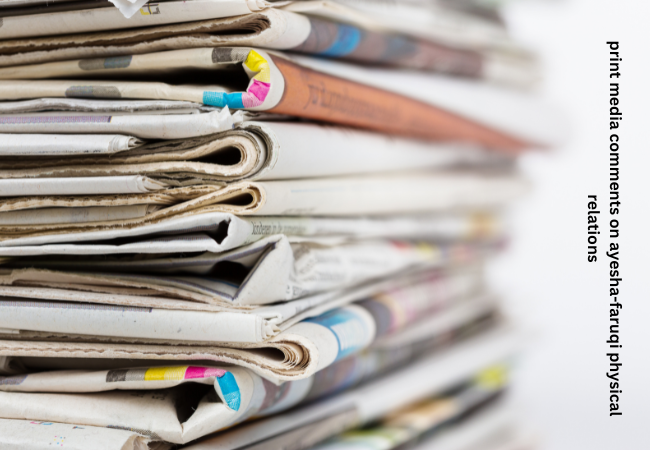Print media comments on ayesha-faruqi physical relations

The role of print media in shaping public opinion cannot be overstated. When it comes to high-profile personalities like Ayesha Faruqi, the scrutiny of personal lives often takes center stage. This article delves into the print media’s comments on Ayesha Faruqi’s physical relations, examining the historical context, the nature of the coverage, public reactions, and the broader implications for journalism and privacy.
Historical Context of print media comments on ayesha-faruqi physical relations on Personal Lives
Evolution of Print Media’s Role
Print Media vs. Digital Media
The rise of digital media has significantly impacted traditional print journalism. While digital platforms offer immediacy and a wider reach, print media still holds a unique position in terms of perceived credibility and in-depth analysis. This dynamic influences how stories like those involving Ayesha Faruqi are covered.
Profile of Ayesha Faruqi
Personal Background
Ayesha Faruqi is a renowned figure known for her contributions in her field. Her personal background, including her upbringing and career trajectory, adds layers to the public’s perception of her, making any media coverage about her even more impactful.
Public Image and Career
Faruqi’s public image is that of a successful and influential individual. Her career achievements have earned her respect and recognition, but this visibility also makes her a frequent subject of media scrutiny, particularly regarding her personal life.
Incident Overview
Timeline of Events
The timeline of events surrounding the media comments on Ayesha Faruqi’s physical relations provides a structured narrative of how the story unfolded. From the initial reports to subsequent reactions, understanding this timeline is crucial for contextual analysis.
Initial Reactions
Initial reactions from the public and various stakeholders set the tone for how the incident was perceived and covered. These reactions often influence the direction of further media coverage and public discourse.
Print Media Coverage
Major Newspapers’ Responses
Major newspapers play a critical role in shaping public opinion. Their responses to the Ayesha Faruqi incident, including front-page stories and in-depth articles, reflect their editorial stance and influence on the readership.
Magazine Articles and Columns
Magazines and columns often provide more personal and opinionated takes on incidents. Analyzing these pieces offers insight into the broader cultural and social implications of the media coverage.
Types of Comments
News Reports
News reports typically aim to present facts and provide an account of events. However, the framing and choice of language can significantly impact the reader’s perception.
Opinion Pieces
Opinion pieces reflect the individual views of the writers and can vary widely in tone and perspective. They often provoke public debate and can be both influential and controversial.
Editorials
Editorials represent the official stance of the publication and are crucial in understanding the broader media narrative. They offer a consolidated view that can sway public opinion.
Public Reaction to Print Media Comments
Social Media Backlash
Social media platforms provide an immediate outlet for public reaction. The backlash on these platforms often highlights the disconnect between traditional media and public sentiment, especially among younger demographics.
Public Statements
Public statements from Ayesha Faruqi and other involved parties add another layer to the narrative. These statements can clarify positions, refute claims, or provide additional context.
Analysis of Media Bias
Sensationalism in Print Media
Sensationalism is a common critique of print media, especially in cases involving personal lives. Analyzing the extent of sensationalism in the coverage of Ayesha Faruqi’s relations helps in understanding the media’s priorities and ethics.
Ethical Journalism
Ethical journalism emphasizes accuracy, fairness, and respect for privacy. This section explores how well print media adhered to these principles in the coverage of this incident.
Impact on Ayesha Faruqi
Personal Repercussions
The personal repercussions for Ayesha Faruqi, including emotional and psychological effects, are significant. Media scrutiny can profoundly impact an individual’s personal life.
Professional Consequences
Professionally, media coverage can affect Faruqi’s career and public standing. This section examines any direct or indirect professional consequences resulting from the incident.

Legal Aspects
Defamation Lawsuits
Defamation lawsuits are a common response to damaging media coverage. This section discusses any legal actions taken by or against Ayesha Faruqi in response to the print media comments.
Privacy Rights
Privacy rights are a central concern in cases like this. The legal framework surrounding privacy and how it applies to public figures is analyzed here.
Comparison with Other Similar Cases
Historical Cases
Comparing this incident with historical cases of similar nature provides a broader perspective on media behavior and public reaction over time.
Recent Examples
Recent examples of similar media coverage help in understanding current trends and the evolving nature of journalism.
Role of Ethics in Journalism
Journalistic Integrity
Journalistic integrity involves adhering to ethical standards and ensuring balanced reporting. This section evaluates how well these principles were upheld in this case.
Codes of Conduct
Codes of conduct in journalism provide guidelines for ethical behavior. The adherence to these codes by print media in the coverage of Ayesha Faruqi is examined here.
Public Figures and Privacy
Balancing Act
The balance between the public’s right to know and an individual’s right to privacy is delicate. This section discusses how this balance was managed in the case of Ayesha Faruqi.
Right to Privacy
The right to privacy for public figures is often contested. This section delves into the legal and ethical considerations surrounding this right.
Gender Perspectives
Gender Bias in Media
Gender bias in media coverage is a critical issue. Analyzing the coverage of Ayesha Faruqi’s relations through a gender lens reveals underlying biases and societal attitudes.
Case Studies
Case studies of other public figures who faced similar media scrutiny provide comparative insights and highlight patterns of gender bias.
Cultural Impact
Cultural Sensitivities
Cultural sensitivities influence media coverage and public perception. This section examines how cultural factors played a role in the coverage of Ayesha Faruqi’s personal life.
Media Influence on Public Perception
The media’s influence on public perception is profound. This section explores how the coverage shaped public attitudes towards print media comments on ayesha-faruqi physical relations and similar incidents.
Future of Print Media
Adapting to Digital Age
Print media faces the challenge of adapting to the digital age while maintaining credibility. This section discusses the strategies and transformations within the industry.
Trust and Credibility Issues
Trust and credibility are paramount for print media. The impact of incidents like this on the credibility of print media is analyzed here.
Conclusion
Summary of Key Points
A summary of the key points discussed in the article, highlighting the main insights and conclusions.
Final Thoughts
Final thoughts on the broader implications of the media coverage of Ayesha Faruqi’s personal life, reflecting on the future of journalism and privacy.



